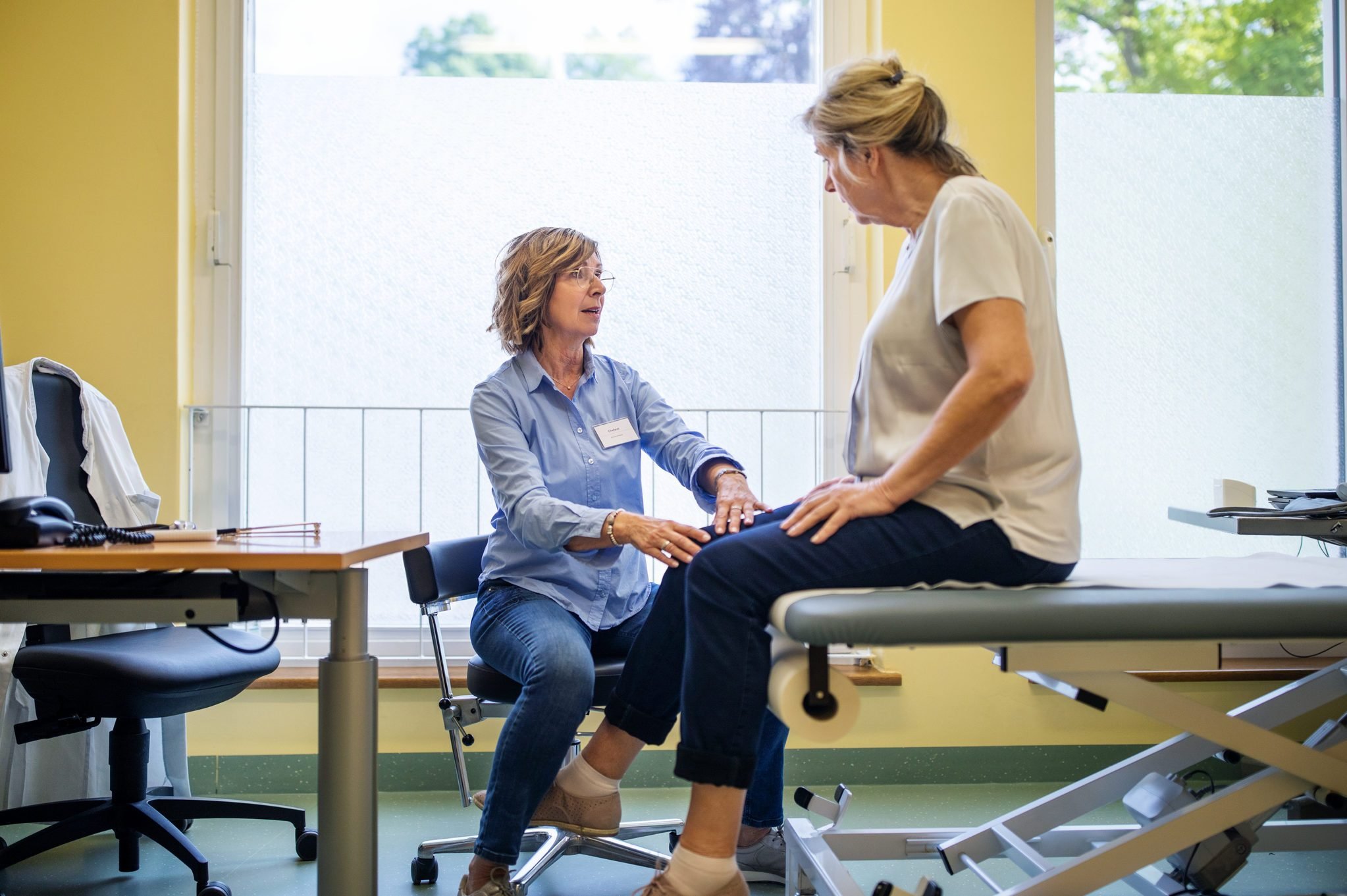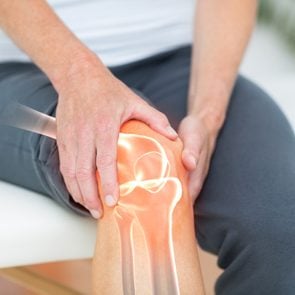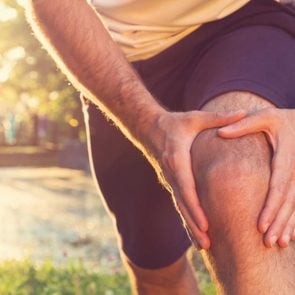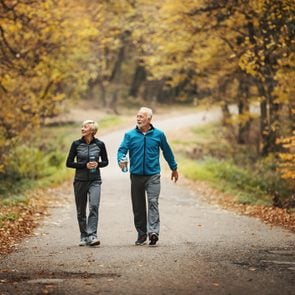8 Causes of Knee Pain When Squatting
Updated: Apr. 28, 2021
There are a lot of reasons you may feel knee pain while squatting. Here are some likely culprits, plus how to prevent and treat the pain.
Everyday squatting
Squatting is one of the main movement patterns of everyday life. You squat when you go from sitting in your office chair to standing up, and you likely do lots of squats when working out.
While squatting should never lead to pain, sometimes aches can pop up for people, especially at the knee. Here’s what to know about knee pain while squatting, including causes, prevention, and treatment.
Causes of knee pain while squatting
Poor form
People often experience knee pain while squatting simply because they’re not doing the exercise correctly, says physical therapist Heather Jeffcoat, DPT, owner of Fusion Wellness and Physical Therapy in Los Angeles.
For starters, when your knees extend too far over your toes—meaning you’re not sitting back into your squat at the hips—you send more pressure into the knee joint than when you allow the glutes (the muscles in your butt) to help you out. This can lead to knee pain, Jeffcoat says.
Next time you do a squat, watch yourself in the mirror from the side. Make sure that you’re sending your hips back, as if you’re about to sit on a chair. And adjust your stance so your knees don’t track too far over your toes.
Another common misstep in the squat form is rotating your hips inward, which forces the knees to drop toward each other as you squat. Jeffcoat points to another possible cause of collapsing knees during a squat: a weakness in the external hip rotators—aka your glute medius and tensor fasciae latae muscles—which play a role in stabilizing the hip and knee.
Not sure if you’re making this common mistake? Watch yourself in a mirror, looking forward. If your knees buckle inward, this poor squat form may be behind your knee pain, Jeffcoat says. To correct it, drive the knees outward—they should align with your toes.
Using a mini resistance band around the thighs while you squat will help you build strength in these muscles, as will side-stepping with the band or doing glute bridges with abduction at the top as you wear the band. Here’s how to do a glute bridge:
- Lie face up on the floor, knees bent and feet flat on the floor. The resistance band should loop just above the knees, held taut.
- Raise your hips until your torso is in a straight line from shoulder to knee.
- Push your knees out to the side, tensing against the resistance band. Bring back to the center, lower your torso to the ground, and repeat.
Finally, going too deep into a squat may also cause knee pain, Jeffcoat says. So, if you’re feeling fine for most of the squat until you hit the lowest point, try keeping your squat shallow and make sure you’re using proper form techniques no matter how low you go.
Lack of flexibility
If you have tight quads, hamstrings, calves, or adductors (inner thighs), you could experience pain in the knee as you perform a squat, Jeffcoat says. This can contribute to poor form (like the knees falling inward or reaching too far over the toes), which can also exacerbate knee pain.
Make sure to incorporate mobility and flexibility training in your weekly workout schedule so you can sidestep knee pain due to range of motion limits in your lower body. Movements or holds like quad, calf, and hip flexor stretches can help.
Muscle strains or tendonitis
If you’re doing squats in your workouts, you want to slowly build up your weight and reps and sets to avoid muscle strains, says Amanda Weiss Kelly, MD, chief of the division of pediatric sports medicine at University Hospitals Rainbow Babies & Children’s Hospital.
“If you’re normally doing three sets of 10 reps with 80 pounds, and then went to four sets of 15 with 100 pounds, that will be a problem,” she says. This can lead to overuse injuries like muscle strains or even inflammation of the tendon, a condition known as tendonitis.
You can get tendonitis of the patella tendon, which runs from the kneecap to the shin bone, Dr. Kelly says. You can also experience tendonitis in the quadriceps tendon (aka the quad) on the front of the upper leg, or you can get hamstring tendonitis, which occurs on the back of the upper leg.
All of these can stem from overuse and lead to pain in the knee while squatting.
To safely build up your weight or volume when squatting, think about the 10 percent rule: Add only 10 percent more reps, sets, or weight each week, Dr. Kelly says.
Continue to build for three to four weeks, then pull back by 10 percent for a week, and continue building again. This gives your body the rest it needs without pushing it too far too fast.

Meniscus tear
The meniscus, or cartilage at the knee, acts as shock absorbers between your thighbone and shinbone, and there are two of these cushions on either side of the knee joint, according to the American Academy of Orthopaedic Surgeons.
If you have a tear at the medial or lateral meniscus, you could feel pain while squatting. This type of pain often feels like the knee is locking, catching, or pinching, Jeffcoat explains.
Those who play sports, especially contact sports, are more prone to meniscus tears, as are older individuals.
Most often, you need an MRI to confirm a meniscus tear, though your doctor will likely start with an X-ray.
In some cases, you might need surgery to repair a tear in the meniscus, but that depends on the severity and location of the tear. Resting your knee may also help.
ACL or PCL tear
There are several ligaments of the knee that keep it stable, including the anterior cruciate ligament (ACL) and the posterior cruciate ligament (PCL). Trauma, like a fall, can cause a tear in any of the ligaments, which can then lead to pain while squatting.
Tears in the ACL or PCL often also come with a medial meniscus tear, Jeffcoat says. This can make your knee feel unstable rather than in pain. But you may experience aches, too.
Playing sports that require you to change directions suddenly or quickly stop running can all lead to an ACL or PCL tear. So can activies where you might land from a jump incorrectly or take a direct blow to the knee.
ACL and PCL tears often require an X-ray and/or MRI to confirm the damage. A tear may require surgery, but sometimes rest, a brace, or physical therapy can help.
Osteoarthritis
Osteoarthritis often occurs with age, but trauma (like a meniscus tear) can increase your risk of the condition. More than 32 million U.S. adults have osteoarthritis, according to the Centers for Disease Control and Prevention (CDC).
Symptoms can include pain, stiffness, swelling, and limited range of motion.
X-rays, lab tests, and a physical exam can help confirm an osteoarthritis diagnosis. Support from a physical therapist to strengthen your muscles, improve mechanics, and increase physical activity can ease the pain associated with this condition.
Patellofemoral pain syndrome
People who play sports are more prone to patellofemoral pain syndrome, also known as runner’s knee. This condition is a broad term for pain at the front of the knee or the patella (kneecap).
“The patella, or kneecap, is supposed to glide down and up as you squat,” Jeffcoat explains. If you have this condition, the kneecap can come out of the groove where it easily glides, putting pressure on the back of the patella and the soft tissues around it. This leads to pain.
The condition is often caused by overuse—say, running too far or too hard without easing into it, or doing constant stair climbs or squats. Muscle imbalances or weakness and poor running or squatting technique may also contribute to the condition.
If your knees fall in toward each other when squatting, and you’re repetitively squatting, this can cause rubbing under the kneecap, the abnormal wearing of the cartilage under the knee cap, and patellofemoral pain, Dr. Kelly says.
Your doctor may order an X-ray or MRI to rule out other causes of your knee pain.
Taking time away from your typical exercise schedule and giving your knee some rest will help alleviate the aches. These runner’s knee exercises can help strengthen your muscles to avoid pain in the future. Your doctor might also suggest anti-inflammatory meds, like ibuprofen. Physical therapy can help, as can shoe orthotics that assist alignment. Surgery is rarely needed.
Synovial plica syndrome
Synovial plica syndrome (or SPS), also known as knee plica syndrome, often comes from overuse. There are normally four plica (folds in the tissue of the knee joint): suprapatellar, medialpatellar (most commonly affected), infrapatellar, or lateral, according to The Surgery Journal.
This condition is usually characterized by pain near the inside (medial side) of the knee, toward the front and above where your kneecap is, Jeffcoat explains.
A clicking, catching, or snapping sensation might also be a symptom of SPS, particularly when you bend and extend the knee (as you do in a squat).
Poor body mechanics while performing squats, using too much weight, and doing too many reps can all lead to the condition, Jeffcoat says.
A health history and series of movement tests help doctors diagnose SPS. Modifying exercises like the squat, lifting lighter weights, and taking more rest days might help alleviate the pain.
When to see a doctor
A single incident of knee pain while squatting probably doesn’t mean you have to seek medical help, but if you’re feeling it constantly or consistently, then it’s time to call in the pros, Jeffcoat says.
Numbness, tingling, or muscle weakness are also signs it’s time to see a doctor. And, of course, if you experience a traumatic event, such as a serious fall, it’s best to get your knee checked out by a medical provider.
Next: This is how many squats it takes to see results.



